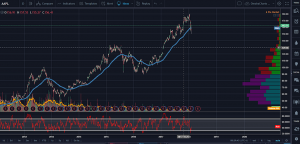There was an article this morning on Marketwatch that I could hardly believe was printed.
“You Can No Longer Trust The 200 Day Moving Average As A Stock Market Indicator” (link above)
For those who may not be familiar, moving averages are a basic tool that help smooth out day to day price fluctuations making past trends in price easier to spot. There are different types of moving averages but for the purposes of this article we will keep it simple and refer to the SMA, or Simple Moving Average.
The Simple Moving Average is calculated by taking the sum of all the past closing prices over a specific time period, and dividing that result by the total number of prices used in the calculation. Just like you learned how to do in grade school.
Here is a chart of Apple, with a 200 day Moving Average added in blue.

You can see that price has fallen below the 200 day Moving Average with the most recent sell off in Apple. In the old technical analysis text books you will come across authors telling you to SELL a stock if a certain moving average in breached. Their thinking is that the line serves as a support level, and since support has been breached it’s time to get out.
Other authors and schools of thinking may push systems whereby you buy once there is a break above a moving average, or buy when a shorter term faster moving average crosses above a longer term slower moving average from below, for example buy a stock when its 50 day Moving Average crosses above the 100 day Moving Average from below.
I have tested such systems across US equities and futures and the result is hardly better than chance, for either of those strategies above, taking into account large amounts of historical data.
While moving averages will retain their place in a technician’s toolbox until the end of time, there has been a fundamental shift in the mechanics of the market that have rendered their traditional usage nearly worthless.
Notice I said “traditional usage.” They do have utility, but not in ways that the old textbooks teach. This theory comes from the notion of the market being a pain trade mechanism. I heard it once referred to as a big wh*re, out to fu*k as many people as it possibly can. So sorry.
Algorithmic trading systems and big money know all the rules and techniques of the technical analysis books of the yesteryear. They know you got “Technical Analysis For Dummies” for Christmas and you are eager to put your newly minted moving average cross system to the test. And here they are waiting for you…

They are faster than you, emotionless and have a lot more money. Using our Apple example from above let’s say that your Christmas gift told you that you should sell your Apple shares should the stock breach its 200 day moving average. For example, the 200 day may be sitting at $158 and the stock is currently trading at $159.50. Algo systems know there are a whole host of smaller retail traders watching this specific level, and that their chances of muscling them out to buy the stock at a lower price are good.
In the blink of an eye, you are watching your stop loss trigger at the 200 day moving average, selling you out of your shares, and minutes (or seconds) later the stock is back up trading above $160. Sonofa…
Is your “Technical Analysis For Dummies” book as good as garbage already? Not at all. You just need to be aware that big money knows what little money is looking to do. Knowing that, you can adjust your strategy, and take advantage of it.
This type of behavior doesn’t stop with moving averages. How successful have you been trading with indicators like MACD, Stochastics, Bollinger Band Breakouts, RSIs, etc? At least in the traditional sense. Likely you aren’t killing it.
Educate yourself on all of the traditional technical tools, and then accept that everyone else knows about them too. A fundamental understanding of market points of interest will allow you to game the big money, and stay one step ahead of them.
All of the stops around the $AAPL 200 day moving average were run several sessions ago. Guess who was there buying Apple stock that day.
You guessed it.
OC
